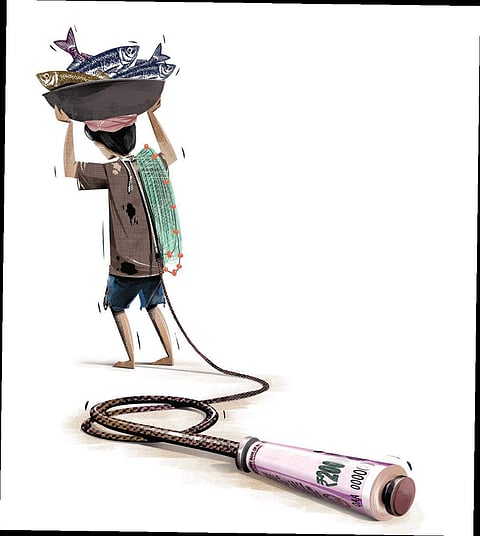

HYDERABAD: Three years ago, over 106 fisherfolk including 46 minors belonging to the Chenchu tribe were rescued from bonded labour in Amaragiri, Nagarkurnool. However, according to NGO data, 27 of those labourers have not received their release certificates (RC) till date. A release certificate can absolve bonded labourers of all their pending loans and entitles them to receive rehabilitation under the Central Sector Scheme for Rehabilitation of Bonded Labourers (2016). The scheme also provides them with a compensation of Rs 20,000 to Rs 2 lakhs.
The Chenchu tribe primarily undertook fishing in the Krishna River. They used to sell their fishes to a few contractors, who had a monopoly on the market, for an advance payment in return.
However, there was a catch. The contractors placed a condition that the fisherfolk would have to repay the advance by supplying fish solely to them, that too at a cost as low as `20/kg against the market value of Rs 100-Rs150/kg. To make ends meet, several tribals took the advance money, in turn, pushing over 64 families to an unending cycle of debt.
“Though the tribals were rescued in 2016, even to this date, only 55 have received their RCs from the revenue department and the sub-divisional magistrate. The others have not received their RCs or the sanctioned compensation,” said Dr K Krishnan, executive director, National Adivasi Solidarity Council (NASC), who was part of the initial rescue of the tribals.
He said that this was due to the apathy of the government in comprehending how bonded labour worked. “The entire process was delayed because the districts were reorganised. As a result, the officials kept changing posts. However, the primary concern is that the officials are in denial of the fact that this could also be a form of bonded labour,” added Dr Krishnan.
Officials from the State Resource Centre to abolish child and adolescent labour agree. They say that steps will be taken, henceforth, to change the situation. “The bonded labour in today’s world has been so invisibilised and complicated that one may not see people in chains the image that the term ‘bondage’ usually evokes,” explained Varsha Bharghavi, SRC coordinator.
She further says that any context, wherein the labour force does not get a fair price for their products and has to forfeit their right to sell their produce at market value, qualifies for bonded labour. “The Chenchu tribe’s situation is what the new form of bonded labour looks like: it seems like they have the right to live their life the way they want, however, they have no right to earn what they deserve,” added Varsha.
The ramifications of not receiving the RC and having no support from the government are such that these labourers are now being forced to re-enter bonded labour. “All those who were rescued are struggling to restart their lives as there are no simultaneous rehabilitation efforts. They have no awareness of their rights. As a result, they have little scope of finding an alternative to fishing,” said Varsha.
New, ‘invisibilised’ bonded labour
“The Chenchu tribe’s situation is what the new and invisibilised form of bonded labour looks like: it seems like they have the right to live their lives the way they want, but they have no right to earn what they deserve,” said Varsha Bharghavi, SRC coordinator